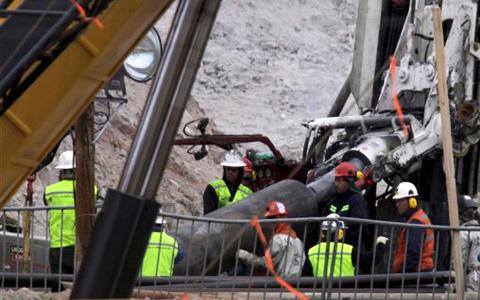Photo: AP
Rescue workers insert steel pipes to encase the escape tunnel that will be used to free trapped miners
at the San Jose mine near Copiapo, Chile. 10 Oct 2010.
Chilean emergency crews have successfully tested a rescue hatch designed to retrieve 33 miners
trapped underground since August 5. Officials plan to begin lifting the men one-by-one to the surface
earlyWednesday.
Rescue crews in Chile lowered the rescue device 610 meters into the rescue shaft, just 12-meters
short of the chamber where the miners are trapped in northern Chile. Officials authorized the test after
crews finished placing steel lining along the top portion of the shaft, to minimize concerns about possible falling rocks or dust.
Mining Minister Laurence Golborne said the results of the initial test with the hatch, known as the Phoenix, were very promising.
Golborne said the rescue hatch performed well on both lined and unlined portions of the shaft. He said
there were no signs of falling dust or other debris.
Chilean navy engineers and mining experts helped build the Phoenix, which is about 50cm wide and includes an oxygen supply and a phone to communicate with rescue crews on the surface.
Andres Sougarret, head of rescue operations, said crews are completing work on an Austrian-built winch that will lower the device in to the mine shaft and pull the miners to the surface.
He said if they encounter no problems, then the rescue operation may begin early Wednesday.
Sougarret said engineers plan to conduct additional tests before the rescue operation begins, adding
that the first people to ride in the hatch will be rescue personnel.
Officials say two mining experts and two paramedics will descend into the mine shaft to help the miners in the final rescue phase.
Health officials have been monitoring the miners' health and providing them a special diet in recent weeks.
Health Minister Jaime Mañalich said the latest indication from the miners shows their health conditions
are stable, even after more than two months underground. He said officials will consider the status of
each miner when they decide who will surface first.
Mañalich said the decision on the first miner to be rescued will be made moments before the operation
begins. He said there is a group of 10 miners with delicate health conditions, who will have priority for
rescue.
Mañalich added that paramedic crews and military helicopters have been rehearsing the steps needed
to fly miners to a nearby hospital after their rescue. Officials say the 32 Chileans and one Bolivian
miner will be monitored for weeks to come to ensure their physical and mental health.
voanews.com Brian Wagner | Miam 11 October 2010





 "У нас есть свобода, но не осталось времени" Dolores ORiordan
"У нас есть свобода, но не осталось времени" Dolores ORiordan 